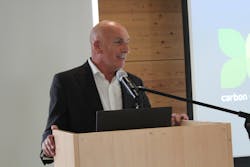INNOVATION | U.K. lighting sector breathes new life into remanufacturing concept
“What’s old is new again” could not be truer when describing the latest eco movement in the lighting industry: remanufacturing. As the name implies, it entails overhauling existing lighting products installed within a project rather than replacing them with new models. Old fixtures essentially become new again.
Still, the phrase has a double meaning, as the practice itself is not new. Remanufacturing has been around for a long time, under monikers like “refurbishing,” “reconditioning,” “re-use,” “restore,” today’s in-vogue “remanufacturing,” and by other tags. Yet it has not been a remarkably popular tactic among lighting customers looking to revitalize their environments.
That attitude is changing as more lighting vendors and specialists gear up to provide remanufacturing products and services, as the eco-minded market awakens, and as end users in Europe and Britain face fluorescent bans that will force them to consider new lighting — although remanufacturing also applies to LED-to-LED upgrades.
Suddenly, remanufacturing is coming out of the back rooms and stepping into a spotlight. Why now?
In the past, users might have refreshed their old lights as a means to save money; now they are driven by environmental concerns. Remanufacturing enthusiasts are quick to point out that it reduces the extraction of raw materials and emitted carbon in the process. That increasingly matters to buyers.
Just ask someone who has been in the business for well over a decade, and whose company is probably the largest of all British lighting remanufacturers.
“The driver when this started 12 years ago was financial, it wasn’t environmental,” said David Clements, CEO of Future Designs, a lighting company based in Edenbridge, Kent, England. “It’s become environmental over the last three to four years, particularly among the big corporates.”
Clements was speaking at the April Remanufacturing Lighting Conference in London. The event was organized by Croydon, England–based Recolight, a not-for-profit company that has run a recycling scheme for about two decades and is now expanding to become a leader in the remanufacturing movement.
From Recolight’s perspective, the recycling and remanufacturing processes each have their place. To help catalyze remanufacturing, the organization used the RLC to announce an online marketplace called Circular Portal. This site, launching in late June, will match remanufacturing buyers, sellers, and other members of the value chain with each other. Circular Portal will “help for recycling not to be the first and primary action for used fittings,” Recolight membership coordinator Francesca Cameron told the conference.
The conference brought together a number of British remanufacturers, some of which also offer new lighting products and services. Some firms are strictly remanufacturers; others have entered the business through alliances with other entities.
In addition to Future Designs, remanufacturers that shared insights and case studies included Glasgow-based Egg Lighting; Gamlingay-based designer F Mark through its collaboration The Regen Initiative; Aylesbury-based LlumarLite Lighting Solutions; Dewsbury-based companies — Gamma Illumination and Martech UK; Swanwick-based Commercial Lighting; and the U.K. division of Austria’s Tridonic.
Together, they sketched a picture of a promising industry full of learning experiences and surprises, with more to come. The nitty-gritty process involves first scoping out a site to ascertain its suitability for incorporating remanufactured products, including evaluating photometric and glare ramifications; sending lights off and overhauling them; and returning them for reinstallation, with plenty of challenges. The mission spans the gamut of not only physically conceiving and doing the job, but also navigating compliance, legal, and ownership issues.
Mistakes, I’ve made a few
“We made huge mistakes when we started,” said Future Designs' Clements. “In cleaning processes, components, [we were spraying] aerosol cans full of stuff …on light fittings that wasn’t the right stuff to clean it with. We all make huge mistakes in what we do.” The important part, he added, is not repeating mistakes.
Future appears to have learned well. Its first remanufacturing job was in London’s Canary Wharf high-rise commercial and financial district, approximately 13 years ago. The firm now claims to have remanufactured lighting across 3 million square feet of offices, universities, and police stations in the capital. It has reworked the lighting in edifices ranging from modern to historic, including One Canada Square, Imperial College, Waterloo Place, 7 More London, and 10 Upper Bank St.
For The Regen Initiative, remanufacturing entails a careful amount of job-by-job consideration of details.
“Every single project has its own scope and own set of requirements,” said Simon Fisher, who runs design company F Mark. Fisher is also a partner in Regen, which includes Braintree-based lighting company Coco Lighting and Bristol-based electrical contractor Eco Fix UK.
Fisher recounted a successful case in which Regen converted 250 fluorescent tube lights into integrated LED luminaires for the Manchester office of engineering company Arup. It removed the lights late last year; Coco rebuilt them in Braintree about 250 miles away, and sent them back to Arup, where Challenger Lighting Services reinstalled them.
While Coco was able to retain about 85% of the original lighting materials, one make-or-break decision arrived early on: whether to paint the fixtures.
“We were looking at 15-year-old products,” Fisher recalled. “The paint on the metalwork had discolored slightly. The agreement we had was we were not going to take those light fittings away and repaint them to make them brilliant white. You’re not going to have that situation on every single project. But actually, if the client had insisted that we did repaint, it wouldn’t have been a viable project, and we probably would have walked away.”
Oops and lessons learned
Regen did not have as much foresight on another aspect of the job. “We had the added joy, quite late in the process, of the client also asking us to convert from an existing DALI installation into a wireless situation,” Fisher said. “Boy, did I wish that was a question I had asked at the original meeting. It put quite a big [wrench] in the works.” Regen did indeed install Bluetooth — but through a process that was not as easy had they planned for it from the start, he said.
Another remanufacturer, Gamma, whose customers include the United Reform Church in Jesmond near Newcastle, cautioned that remanufacturers should gauge ahead of time whether existing product is in good enough condition to rebuild.
“From the onset, we had to make it clear that the only way this was going to work was if the luminaires were received by us in a serviceable condition,” said Gamma design director Andrew Nixon. “Any significant damage is going to create significant and time-consuming issues.”
Reconditioning is also not for the fainthearted. Nixon described units that came from the church full of bird mess. F Mark’s Fisher recalled others from customer NFU Mutual Insurance, some of which had exploded capacitors, and another that hosted a wasps’ nest.
Beware certification
Physicality aside, remanufacturers face a considerable and potentially costly task in certifying their goods with safety labels such as the UKCA, which is similar to the UL marking in the U.S. and CE in Europe.
“Ultimately, a remanufacturer is going to have to take legal responsibility for the product that they place back on the market,” cautioned Tom Ruddell, lead remanufacture engineer with Egg. “And they’re going to do that by affixing compliance marking onto the product that identifies them solely as the legal producer of that product.”
Ruddell entreated remanufacturers to make this clear to their potential customers in upfront negotiations, because the cost of certification can be prohibitively high. In the U.K., manufacturers self-certify to government standards, or they can hire third parties for certification. Either way, it is pricey, and if the customer is not willing to pay for it, then the deal could well be off, he said.
Remanufacturing will not always be the way to go. Sometimes recycling will make more sense. And sometimes buyers may want to consider purchasing new equipment designed from the ground up with green concepts. Vendors are increasingly building luminaires using recovered materials. Fagerhult recently introduced luminaires that deploy reflectors made with reflective polyethylene terephthalate (PET) recovered from discarded television sets, and Glamox unveiled a line of luminaires made from recycled aluminum this past February.
Also that month, Signify added a couple of luminaires for use in retail shops, some deploying recycled materials and others “bio-based plastics.” The company’s best known eco-design product is probably its 3D-printed Coastal Breeze luminaire, fabricated with filament from old fishnets.
While remanufacturing can sometimes compete against “new,” the two could also take hold together.
“[In] one of the projects we worked on at Regen, we had the Signify 3D-printed downlights pitched on that job,” said Fisher. “We have yet to hear whether we’ve won or not. But that’s going hand in hand with remanufacturing. They all have their own places. Anything that’s moving in a sustainable, ecological direction should be applauded. Remanufacturing sits as part of that process.”
In other words, a lot of good old ideas are out there, ready for new life.
MARK HALPER is a contributing editor for LEDs Magazine, and an energy, technology, and business journalist ([email protected]).
Follow our LinkedIn page for our latest news updates, contributed articles, and commentary, and our Facebook page for events announcements and more. You can also find us on Twitter.

Mark Halper | Contributing Editor, LEDs Magazine, and Business/Energy/Technology Journalist
Mark Halper is a freelance business, technology, and science journalist who covers everything from media moguls to subatomic particles. Halper has written from locations around the world for TIME Magazine, Fortune, Forbes, the New York Times, the Financial Times, the Guardian, CBS, Wired, and many others. A US citizen living in Britain, he cut his journalism teeth cutting and pasting copy for an English-language daily newspaper in Mexico City. Halper has a BA in history from Cornell University.

![“It really did put quite a big [wrench] in the works” when client Arup asked for wireless connectivity late in the remanufacturing process, Regen’s Simon Fisher said. But it all ended well, he noted. “It really did put quite a big [wrench] in the works” when client Arup asked for wireless connectivity late in the remanufacturing process, Regen’s Simon Fisher said. But it all ended well, he noted.](https://img.ledsmagazine.com/files/base/ebm/leds/image/2023/05/SimonFisher.64593886a3117.png?auto=format,compress&fit=max&q=45&w=250&width=250)





![The DesignLights Consortium continues to make progress in shifting outdoor lighting products and implementation practices toward a more restrained and thoughtful strategy. [Image does not represent a DLC qualified fixture.] The DesignLights Consortium continues to make progress in shifting outdoor lighting products and implementation practices toward a more restrained and thoughtful strategy. [Image does not represent a DLC qualified fixture.]](https://img.ledsmagazine.com/files/base/ebm/leds/image/2024/08/66be810888ae93f656446f61-dreamstime_m_265700653.png?auto=format,compress&fit=&q=45&h=139&height=139&w=250&width=250)
